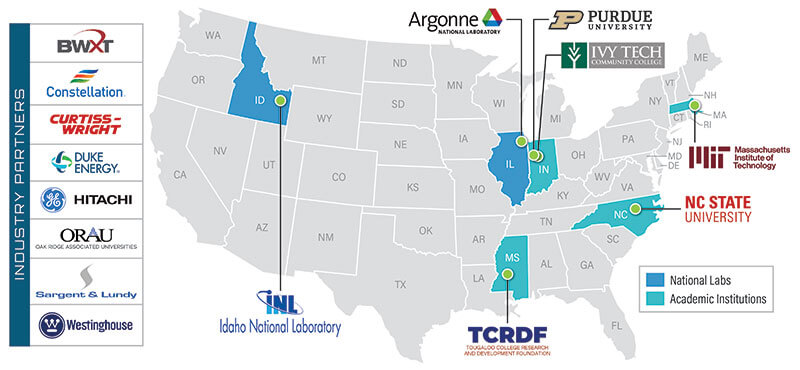Purdue leading $6M DOE-sponsored research for small modular reactor and advanced reactor technologies

WEST LAFAYETTE, Ind. — Purdue University’s longstanding leadership in nuclear energy technologies research has resulted in a $6 million grant from the U.S. Department of Energy to lead a consortium that will revitalize nuclear research facilities and expand university-led research for small modular reactor (SMR) and advanced reactor (AR) technologies. The group consists of five universities and colleges and two national labs, which will work to upgrade research facilities, increase their capabilities and develop programs to educate the future nuclear energy workforce.
Purdue’s Seungjin Kim, the Capt. James F. McCarthy, Jr. and Cheryl E. McCarthy Head of the School of Nuclear Engineering, will lead the collaborative work with Massachusetts Institute of Technology and North Carolina State University. The project’s goal is to revitalize four existing nuclear reactor research facilities and expand research and educational programs, including developing nuclear curricula with Ivy Tech for training skilled trades, as well as programs for underrepresented groups with the Tougaloo College Research and Development Foundation.
The project will establish new cyber-physical capabilities that enable a wide range of SMR and AR technologies. It will establish a user facility composed of four interconnected cyber-physical facilities equipped with state-of-the-art digital instrumentation and control systems, which will serve as a regional center of excellence for research, education and training. The center will promote sharing equipment and instrumentation by universities, national labs, industry partners and other institutions for multidisciplinary research and demonstration. Infrastructure design and development also will be guided and supported by Argonne National Laboratory, Idaho National Laboratory, as well as eight major nuclear industry partners who will facilitate internship and apprenticeship opportunities for students. They are BWX Technologies Inc., Constellation Energy Corp., Curtiss-Wright Corp., Duke Energy Corp., GE Hitachi Nuclear Energy, Oak Ridge Associated Universities, Sargent & Lundy and Westinghouse Electric Co.

Purdue’s leadership and Kim’s expertise in nuclear energy research was in the spotlight earlier this year when the Indiana Office of Energy Development chose Purdue to lead an initiative exploring the feasibility of SMRs for Indiana. Purdue also has been leading the study related to SMR and AR technologies through the Purdue-Duke Energy joint study to explore the feasibility of using advanced nuclear technology for powering Purdue’s West Lafayette campus and its surrounding community.
Kim said the grant from the DOE’s Office of Nuclear Energy reflects Purdue’s tradition of excellence in the nuclear energy field: “These programs will enable synergetic cooperation between educational institutions, national labs, the nuclear industry and policymakers, and help build a sustainable platform for advanced nuclear technology research innovation and the future nuclear workforce.”
Kim is enthusiastic about the potential of all the latest reactor technologies, including SMRs and ARs, which he says improve on their larger reactor counterparts by being “more robust in construction and installation, more flexible in siting, equipped with advanced design features including enhanced safety systems, and dispatchable,” among other attributes.
“One of the exciting things about SMR and AR technologies is that they allow for load-following and hybrid with other renewables like solar and wind,” Kim said. “You can also generate hydrogen without any carbon generation. Additionally, by being smaller and flexible, the electricity generated by SMR and AR can be used toward charging electric vehicles, for example. Nuclear energy can actually be used to create a 100% carbon-free energy ecosystem that would not be possible without it.”
Work supported by the DOE grant will upgrade Purdue’s multidimensional integral test assembly, known as PUMA, which is the only existing scaled integral test facility for advanced light-water reactor designs. PUMA will be refurbished and given new capabilities, including its digital-twin system with a full-scale reactor control room. It will also upgrade Purdue’s existing research reactor (PUR-1), which is the first and only university reactor licensed by the U.S. Nuclear Regulatory Commission for a fully digitized instrument and control system. PUR-1 will be enhanced with a high-fidelity, real-time digital twin with two-way TCP/IP (transmission control protocol/internet protocol) communications. The digital replica of the physical reactor systems will facilitate simulations and analyses to further enhance research toward SMR and AR technologies. In addition, complementary upgrades are planned at MIT and N.C. State, enabling the sharing of unique equipment and instrumentation for studies of advanced nuclear technology concepts.
When established, Kim said, the new and upgraded infrastructure will provide the broader nuclear engineering community with a test bed for cyber-physical research to develop and demonstrate new and potentially revolutionary technologies that include quantum-based cybersecurity, semiautonomous control and remote or unattended operation, digital twinning, diagnostics, and prognostics and sensor placement, among many others related to SMR and AR technology development.
Other Purdue nuclear engineering faculty involved in this project as co-principal investigators are Stylianos Chatzidakis, assistant professor; Mamoru Ishii, the Walter Zinn Distinguished Professor of Nuclear Engineering; Shripad Revankar, professor; and Lefteri Tsoukalas, professor.
About Purdue University
Purdue University is a public research institution demonstrating excellence at scale. Ranked among top 10 public universities and with two colleges in the top four in the United States, Purdue discovers and disseminates knowledge with a quality and at a scale second to none. More than 105,000 students study at Purdue across modalities and locations, including nearly 50,000 in person on the West Lafayette campus. Committed to affordability and accessibility, Purdue’s main campus has frozen tuition 13 years in a row. See how Purdue never stops in the persistent pursuit of the next giant leap — including its first comprehensive urban campus in Indianapolis, the Mitchell E. Daniels, Jr. School of Business, Purdue Computes and the One Health initiative — at https://www.purdue.edu/president/strategic-initiatives.
Writer/Media contact: Amy Raley, araley@purdue.edu
Source: Seungjin Kim, seungjin@purdue.edu